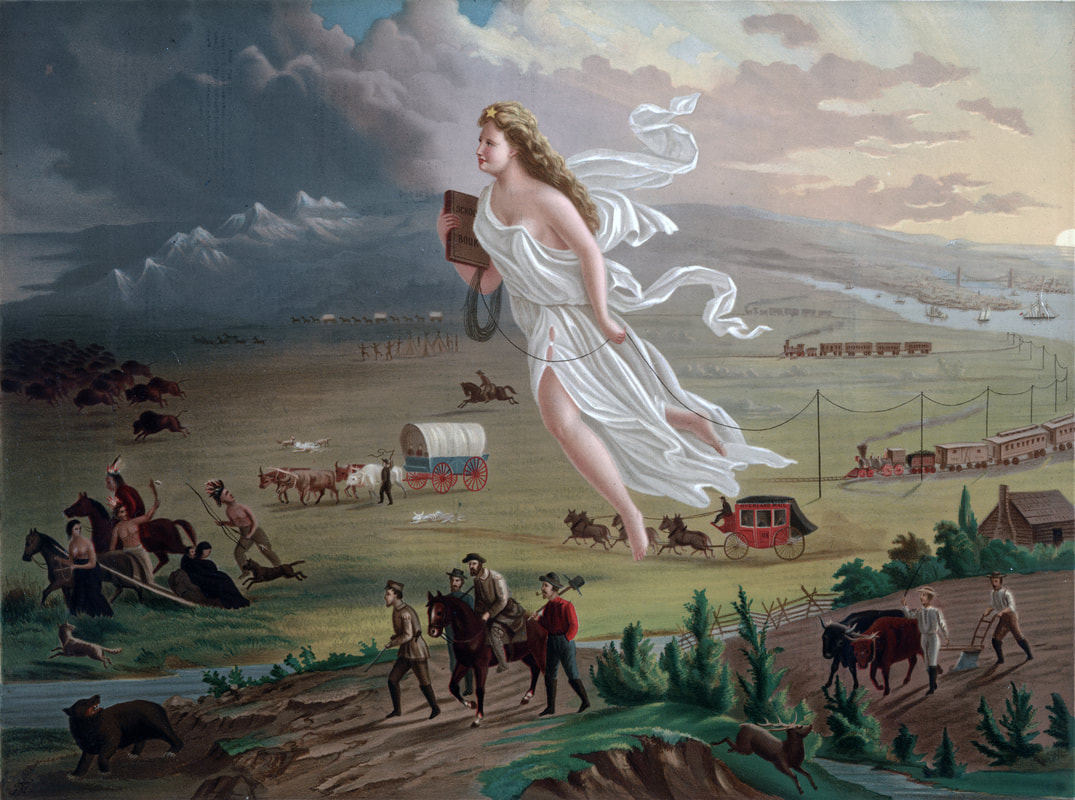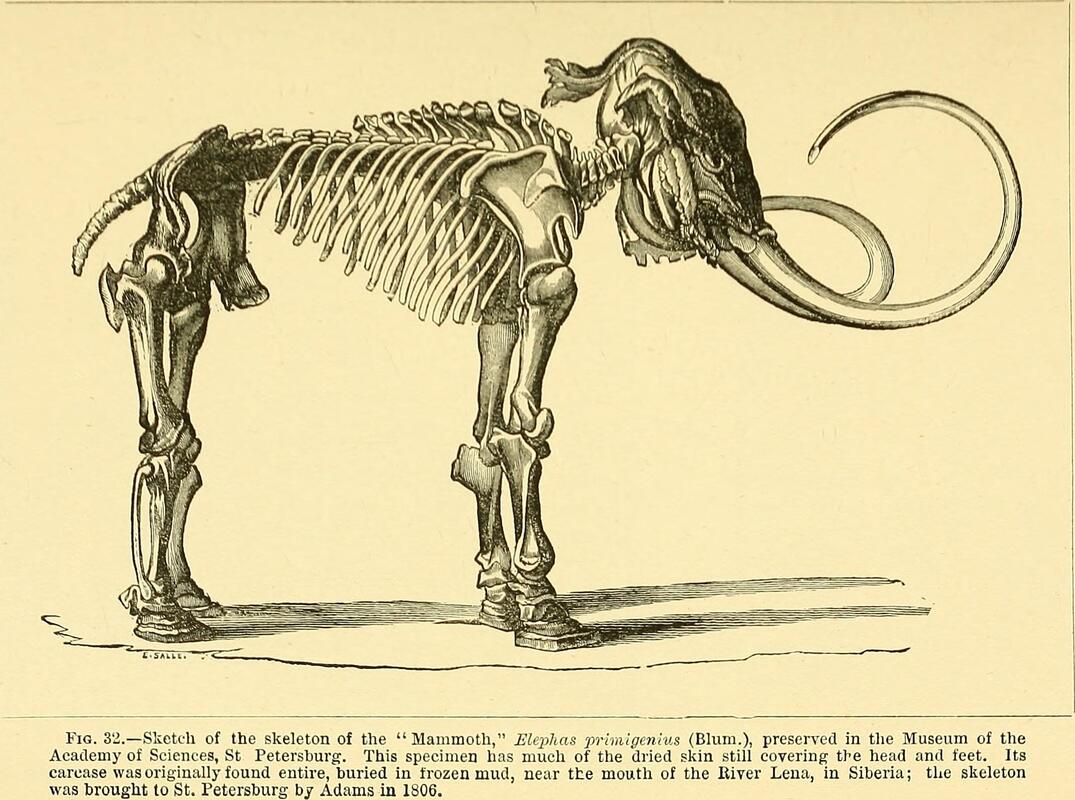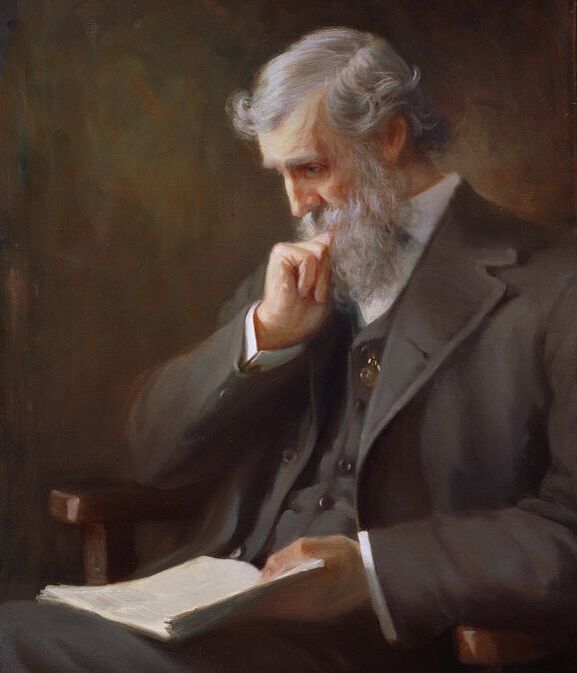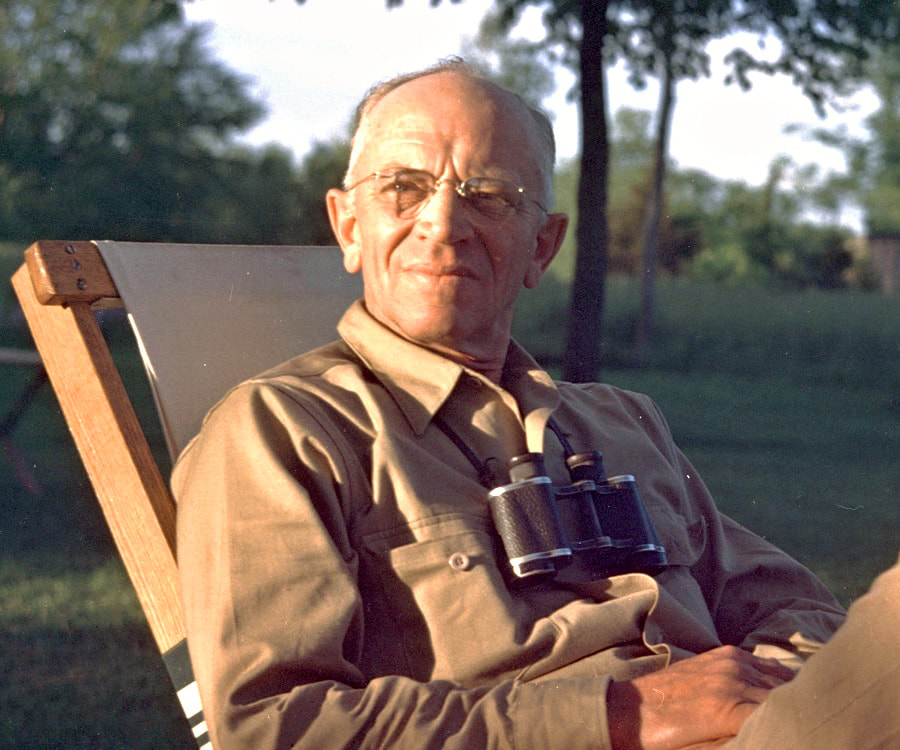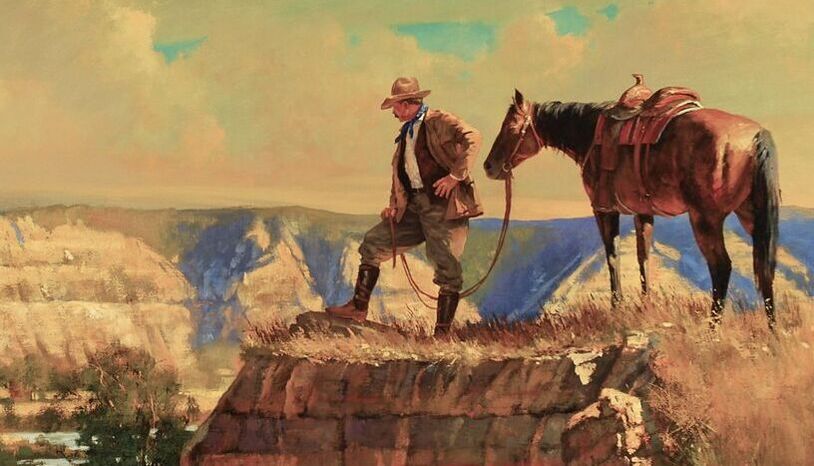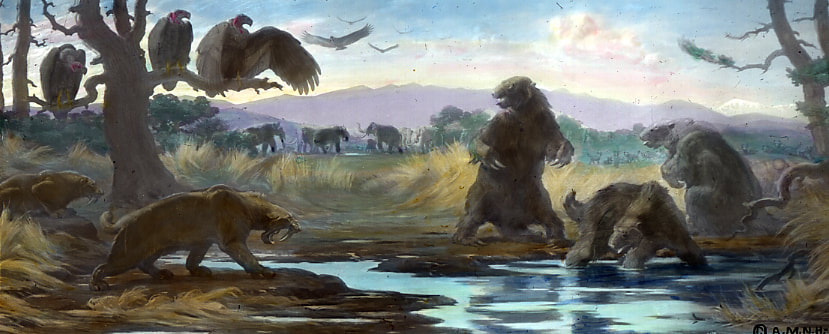We need the tonic of wildness -- to wade sometimes in marshes where the bittern and the meadow-hen lurk, and hear the booming of the snipe; to smell the whispering sedge where only some wilder and more solitary fowl builds her nest, and the mink crawls with its belly close to the ground. At the same time that we are earnest to explore and learn all things, we require that all things be mysterious and unexplorable, that land and sea be infinitely wild, unsurveyed and unfathomed by us because unfathomable. We can never have enough of nature." ~Henry David Thoreau When Thoreau penned those words, he was a fish swimming against the current. He was writing in a Victorian world caught in the stream of the industrial revolution, modernizing, urbanizing, and colonizing. Today, we see wilderness as something precious. It is a threatened, pristine place where one half expects David Attenborough’s voice to come echoing through the trees. To early American pioneers, wilderness was a terrifying adversary, not a thing to be enjoyed. Compared with the pastoral order of the European countryside, “the seemingly boundless wilderness of the New World was something else. In the face of this vast blankness, courage failed and imagination multiplied fears” (Nash 2014, 26). Wilderness was set in opposition to civilization, and became an obstacle to overcome on the road to progress. Lewis Cass, the American Secretary of War stated in 1830 that “there can be no doubt, and such are the views of the elementary writers upon the subject, that the Creator intended the earth should be reclaimed from a state of nature and cultivated” (Cass 1830, 77). In July of 1845 Thoreau began his seclusion near Walden Pond. That same year, in fact, that very same month, an essay titled Annexation was published in the United States Magazine and Democratic Review. Its author, John O’Sullivan, was a nationalistic American columnist, descended from a colorful line of Irish expatriates and soldiers of fortune. Born at sea, he was the son of American diplomat and Sea captain John Thomas O’Sullivan, the third O’Sullivan Baronet of his name. O’Sullivan had his father’s aristocratic manner, and he was a fervent advocate for the prosecution of the Mexican-American War, and later, for the Confederate cause in the Civil War. His name would have been largely forgotten by historians had he not coined one of the most famous ideas in American history: Manifest Destiny. In Annexation, he made the case that it was the manifest destiny of the Anglo-Saxon race to spread across the whole of the American continent “to the possession of the homes conquered from the wilderness by their own labors and dangers, sufferings and sacrifices” (O'Sullivan 1845, 9).
Less than a decade later across the Atlantic, in northern Ireland in the County Cavan, a jaw and teeth were uncovered by mill workers digging a foundation. Several of the teeth came into the possession of the Dublin surgeon Thomas Molyneux, who published an interpretation of the bones in 1715. He based his analysis on comparative anatomy, and quickly became “pretty well convinced they must have been the Grinding Teeth of an Elephant” (Molyneux 1715, 371). Such discoveries were novel in the American colonies, but fossil ivory had been exported from Siberia since antiquity. From at least the time of Peter the Great, reports had filtered into Europe of great bones eroding from the permafrost, which the Mongolians called mammut. In Siberian folklore, they were thought to be a burrowing creature. While Molyneux dismissed the idea that these were the bones of a giant, or some Siberian troglodyte as a groundless claim, he struggled to explain how elephants could have once lived so far north. He wondered at the possibility that “this Terraqueous Globe might, in the earliest Ages of the World, after the Deluge, but before all Records of our oldest Histories, differ widely from its present Geography” (Molyneux 1715, 378). Georges-Louis Leclerc de Buffon was one of the first to suggest that species could die out. In the ninth volume of his Histoire naturelle, he alluded to fossil elephants such as those found at Claverack and the County Cavan (Buffon 1749-88 vol. 9, 126). He grappled with the possibility that these represented an extinct species, but ultimately rejected the idea. Buffon and his anatomist Louis-Jean-Marie Daubenton concluded that “the difference in size, which appeared excessive, seemed sufficient to attribute this bone to another animal that ought to be larger than the elephant. But, since no one knew of any larger animal, it was necessary to resort to the fictitious mammout: this fabulous animal has been imagined in the northern countries, where there are found very frequently the bones, teeth, and tusks of the elephant” (Buffon 1749-88 vol. 11, 170). It was not until 1796, that French anatomist Georges Cuvier revived the idea. He suggested that these were not simply elephant bones found improbably far north, but represented an extinct species (Rudwick 1997). Actually, he identified two distinct species. The Eurasian variety as Mammoth, and the American specimens as Mastodon. When the bones of another great mammal were discovered in northern Argentina, on the bank of the river Luján, Cuvier identified it as an extinct species of giant ground sloth, which he named Megatherium. Evidence was emerging that natural ecosystems could change, and that the landscapes which American frontiersman were settling had once looked quite different.
To white settlers, the American wilderness was a bottomless, untouched trove of resources, frontiers and unfinished maps. Of course, this supposed wilderness was already occupied. 19th century depictions of the indigenous people who found themselves on the wrong side of the colonial encounter painted them as child-like and incapable of advancement. Lewis Cass said of them: “they are in a state of nature, as much so as it is possible for any people to be” (Cass 1830, 74). Influential anthropologists of the day, such as Lewis Henry Morgan and Edward Burnett Tylor, believed that Native Americans could be classified somewhere between savagery and barbarism, with the lowest among them described as little more than animals. Tylor noted that “there are several great linguistic families whose members were discovered in a savage state” throughout North America (Tylor 1871, 52). By these accounts Native Americans were just a feature of the wilderness they inhabited. For men like Roosevelt and Turner, this was implicit in their worldview. This view has long since been banished from academic discourse. Modern archaeological research has proven that Native Americans were adept shapers of their environments. They have transformed ecosystems since they first penetrated the Laurentide and Cordilleran ice sheets at least 15,000 years ago. By 10,350 years ago, humans were cultivating wild plants across the Amazon in artificial raised forest islands, altering the balance of ecosystems (Lombardo et al 2020). Fire regimes in California (Klimaszewski-Patterson and Mensing 2020) and the Great Plains (Roos et al 2018) were re-written by foragers, dictating landscape compositions for thousands of years before Europeans arrived. Ecosystems along the Mississippi were shaped by Maize farmers (Aiuvalasit et al 2020), and the Maya cleared forests and altered water tables in ancient Mesoamerica (Battistel et al 2018). Since Cuvier's time, we have identified dozens of species of megafauna which went extinct in the Americas by the end of the last ice age. Many researchers believe that humans contributed to the extinction of some, or perhaps all, of these megafauna. If this is true, then the ecosystems of North and South America have not been untouched since the first Paleoindians paddled up the Columbia River, or penetrated the rainforests of South America. If there is a wilderness for us to romanticize and to dream of restoring, it is not the ‘wilderness’ that European settlers encountered as they conquered North America. It is a much older wilderness, as old as the first Americans. The end of that wilderness was the extinction of the menagerie of giants that once roamed the continent. References:
Aiuvalasit, Michael, Tim Riley, and Joseph Schuldenrein. “Multiproxy Evidence for Rapid and Enduring Anthropogenic Vegetation Change during the Late Holocene from an Abandoned Channel of the Mississippi River, Wapanocca Bayou, Arkansas, USA.” Geoarchaeology 35, no. 3 (2020): 351–65. https://doi.org/10.1002/gea.21773. Argot, Christine. “Changing Views in Paleontology: The Evolution of a Giant (Megatherium, Xenarthra).” Essay. In Mammalian Evolutionary Morphology A Tribute to Frederick S. Szalay, edited by Eric J. Sargis and Marian Dagosto. Dordrecht: Springer Netherlands, 2008. Battistel, D., M. Roman, A. Marchetti, N. M. Kehrwald, M. Radaelli, E. Balliana, G. Toscano, and C. Barbante. “Anthropogenic Impact in the Maya Lowlands of Petén, Guatemala, during the Last 5500 Years.” Journal of Quaternary Science 33, no. 2 (2018): 166–76. https://doi.org/10.1002/jqs.3013. Buffon, George Louis Leclerc de. Histoire Naturelle, generale et particuliere. 44 vols. Paris: Imprimeries royale, 1749-88 Cass, Lewis. “Removal of the Indians,” North American Review 30 (1830) Klimaszewski-Patterson, Anna, and Scott Mensing. “Paleoecological and Paleolandscape Modeling Support for Pre-Columbian Burning by Native Americans in the Golden Trout Wilderness Area, California, USA.” Landscape Ecology 35, no. 12 (2020): 2659–78. https://doi.org/10.1007/s10980-020-01081-x. Lombardo, Umberto, José Iriarte, Lautaro Hilbert, Javier Ruiz-Pérez, José M. Capriles, and Heinz Veit. “Early Holocene Crop Cultivation and Landscape Modification in Amazonia.” Nature 581, no. 7807 (2020): 190–93. https://doi.org/10.1038/s41586-020-2162-7. Muir, John. My First Summer in the Sierra (1911), reprinted in John Muir: The Eight Wilderness Discovery Books (London, England: Diadem; Seattle, Washington: Mountaineers, 1992), P. 211. Molyneux, John. “Remarks upon aforsaid Letter and Teeth, by Thomas Molyneux, M.D. and R.S.S. Physician to the State of Ireland: Addres’d to his Grace the Lord Archbishop of Dublin,” Philosophical Transcations 29 (1715): 371 Nash, Roderick. Wilderness and the American Mind. New Haven: Yale University Press, 2014. O'Sullivan, John. "Annexation" United States Magazine and Democratic Review (1845) Roos, Christopher I., María Nieves Zedeño, Kacy L. Hollenback, and Mary M. Erlick. “Indigenous Impacts on North American Great Plains Fire Regimes of the Past Millennium.” Proceedings of the National Academy of Sciences 115, no. 32 (2018): 8143–48. https://doi.org/10.1073/pnas.1805259115. S., Rudwick Martin J. Georges Cuvier, Fossil Bones, and Geological Catastrophes, 1998. Semonin, Paul. American Monster: How the Nation's First Prehistoric Creature Became a Symbol of National Identity. New York: New York University Press, 2000. Taylor, Edward, Donald E. Stanford, and J. Dudley. “The Giant Bones of Claverack, New York, 1705.” New York History 40, no. 1 (1959): 47-61. Accessed August 24, 2020. http://www.jstor.org/stable/23153528. Turner, Frederick Jackson. The Frontier in American History.
0 Comments
Your comment will be posted after it is approved.
Leave a Reply. |
We are, as a species, addicted to story. Even when the body goes to sleep, the mind stays up all night telling itself stories." Humans are 90 percent chimp and 10 percent bee." The very ritual practices that the New Atheists dismiss as costly, inefficient and irrational turn out to be a solution to one of the hardest problems humans face: cooperation without kinship” The most powerful force ever known on this planet is human cooperation — a force for construction and destruction.” The human mind is a story processor, not a logic processor." Sports is to war as pornography is to sex." Selfishness beats altruism within groups. Altruistic groups beat selfish groups. Everything else is commentary." Civilization is the interval between Ice Ages." Most of us spend too much time on the last twenty-four hours and too little on the last six thousand years." Philip Larkin famously proposed that what will survive of us is love. Wrong. What will survive of us is plastic, swine bones and lead-207, the stable isotope at the end of the uranium-235 decay chain." We are part mineral beings too – our teeth are reefs, our bones are stones – and there is a geology of the body as well as of the land." However many nations live in the world today, however many countless people, they all had but one dawn." ~Anonymous, Popul Vuh Every step you take has already been taken. Every story has already been told. The land is not newly discovered, so old with legends you might mistake them for rocks." ~Craig Childs The present contains nothing more than the past, and what is found in the effect was already in the cause." ~Henri Bergson Archaeologists may not always see the trees, but we capture the forest with great clarity" ~Robert Kelly The past is never dead; it's not even past." ~William Faulkner No civilization has survived forever. All move toward dissolution, one after the other, like waves of the sea falling upon the shore. None, including ours, is exempt from the universal fate.” ~Douglas Preston If you go into a museum and look at antiquities collected there, you can be sure that the vast bulk of them were found not in buildings but in graves." ~Leonard Woolley Ice breathes. Rock has tides. Mountains ebb and flow. Stone pulses. We live on a restless earth.” ~Robert Macfarlane We always stand on the shoulders of our ancestors, whether or not we look down to acknowledge them." ~David Anthony That which always was, and is, and will be everliving fire, the same for all, the cosmos, made neither by god nor man, replenishes in measure as it burns away." ~Heraclitus Shamanism is not simply a component of society: on the contrary, shamanism, together with its tiered cosmos, can be said to be the overall framework of society." ~David Lewis-Williams Opened are the double doors of the horizon. Unlocked are its bolts." ~Utterance 220 of the Pyramid of Unas If history were taught in the form of stories, it would never be forgotten." ~Rudyard Kipling The mountains are fountains of men as well as of rivers, of glaciers, of fertile soil. The great poets, philosophers, prophets, able men whose thoughts and deeds have moved the world, have come down from the mountains." ~John Muir The ecological thinker is haunted by the consequences of time." ~Garrett Hardin Through the experience of time, Dasein becomes a ‘being towards death’: without death existence would be care-less, would lack the power that draws us to one another and to the world." ~Iain McGillchrist The dead outnumber the living fourteen to one, and we ignore the accumulated experience of such a huge majority of mankind at our peril." ~Niall Ferguson Tell me what you eat and I'll tell you what you are." ~Jean Anthelme Brillat-Savarin We live in a zoologically impoverished world, from which all the hugest and fiercest, and strangest forms have recently disappeared." ~Alfred Russel Wallace Humans have dragged a body with a long hominid history into an overfed, malnourished, sedentary, sunlight-deficient, sleep-deprived, competitive, inequitable, and socially-isolating environment with dire consequences." ~Sebastian Junger Except in geographical scale, tribal warfare could be and often was total war in every modern sense. Like states and empires, smaller societies can make a desolation and call it peace." ~Lawrence Keeley The first people were aware of the signs and signals of the natural world. Their artifacts were projectiles, blades, and ivory sewing needles, either used on animal products, or made from them, or used to procure them. The world around them was a cycle of animals of all sizes, from voles and falcons to some of the largest mammals seen in human evolution." ~Craig Childs The number of herbivores sets a cap on the number of carnivores that can live in a region. Of course, adding an additional predator of fairly large body size, like a modern human, would produce repercussions that would ripple though all the other predators in the area and their prey." ~Pat Shipman When viewed globally, near-time extinctions took place episodically, in a pattern not correlated with climatic change or any known factor other than the spread of our species." ~Paul S. Martin However splendid our languages and cultures, however rich and subtle our minds, however vast our creative powers, the mental process is the product of a brain shaped by the hammer of natural selection upon the anvil of nature." Behavior is imitated, then abstracted into play, formalized into drama and story, crystallized into myth and codified into religion- and only then criticized in philosophy, and provided, post-hoc, with rational underpinnings." I have seen yesterday. I know tomorrow." We are fire creatures from an ice age." ~Stephen Pyne Men come and go, cities rise and fall, whole civilizations appear and disappear-the earth remains, slightly modified." ~Edward Abbey Men and women, empires and cities, thrones, principalities, and powers, mountains, rivers, and unfathomed seas, worlds, spaces, and universes, all have their day, and all must go." ~H. Rider Haggard One day the last portrait of Rembrandt and the last bar of Mozart will have ceased to be- though possibly a colored canvas and a sheet of notes will remain- because the last eye and the last ear accessible to their message will have gone." ~ Oswald Spengler All that is human must retrograde if it does not advance." In the long paleontological perspective, we humans must be considered invasive in any locale except Africa." ~Pat Shipman Of the gladdest moments in human life, methinks, is the departure upon a distant journey into unknown lands. Shaking off with one mighty effort the fetters of Habit, the leaden weight of Routine, the cloak of many Cares and the slavery of Civilization, man feels once more happy." ~Richard Francis Burton Sedentary culture is the goal of civilization. It means the end of its own lifespan and brings about its corruption." ~Ibn Khaldun Tradition is not the worship of ashes, but the preservation of fire." ~Gustav Mahler As for man, his days are numbered. Whatever he might do, it is but wind." ~The Epic of Gilgamesh There is a cave in the mind." Full circle, from the tomb of the womb to the womb of the tomb, we come." ~Joseph Campbell I feel again a spark of that ancient flame." ~ Virgil Man is an animal suspended in webs of significance he himself has spun. I take culture to be those webs, and the analysis of it therefore not to be an experimental science in search of law, but an interpretive one in search of meaning." ~Clifford Geertz In all chaos there is a cosmos, in all disorder a secret order." ~Carl Jung Man fears time, but time fears the pyramids." ~Arab proverb Few romances can ever surpass that of the granite citadel on top of the beetling precipices of Machu Picchu, the crown of Inca Land." ~Hiram Bingham You don't have to be a fantastic hero to do certain things- to compete. You can just be an ordinary chap, sufficiently motivated to reach challenging goals." ~Edmund Hillary Thousands of tired, nerve-shaken, over-civilized people are beginning to find out that going into the mountains is going home; that wildness is a necessity." ~John Muir To speak of truth sounds too grand, too filled with the promise of certainty, and we are rightly suspicious of it. But truth will not go away that easily. The statement that ‘there is no such thing as truth’ is itself a truth statement, and implies that it is truer than its opposite, the statement that ‘truth exists’." ~Lain McGillchrist The Sphinx will always have to be looked after." Yes, the pyramids have been built, but if you give me 300,000 disciplined men and 30 years I could build a bigger one." Civilizations exist by geological consent, subject to change without notice." When at last we anchored in the harbor, off the white town hung between the blazing sky and its reflection in the mirage which swept and rolled over the wide lagoon, then the heat of Arabia came out like a drawn sword and struck us speechless" The best prophet of the future is the past." An archaeologist is the best husband a woman can get. The older she gets the more interested he is in her." Archaeology is the peeping Tom of the sciences. It is the sandbox of men who care not where they are going; they merely want to know where everyone else has been." What would be ugly in a garden constitutes beauty in a mountain." I have never been able to grasp the meaning of time. I don't believe it exists. I've felt this again and again, when alone and out in nature. On such occasions, time does not exist." Myths are public dreams, dreams are private myths. "~Joseph Campbell In my experience, it is rarer to find a really happy person in a circle of millionaires than among vagabonds." Always my soul hungered for less than it had" History is filled with the sound of silken slippers going downstairs, and wooden shoes coming up." Back home, I'm always focusing on something happening in the future. On expeditions, time stops, and you become like a stone age man, acting on instincts and knowing you are part of the universe." Genes are rarely about inevitability, especially when it comes to humans, the brain, or behavior. They're about vulnerability, propensities, tendencies." ~Robert Sapolsky The Land is not old. It only changes, becoming one thing and the next. We are the ones who ascribe age, the brevity of our lives demanding a beginning, middle, and end." Every age has its own outlook. It is specially good at seeing certain truths and specially liable to make certain mistakes. We all, therefore, need the books that will correct the characteristic mistakes of our own period. And that means the old books." The only thing that belongs to us is the time." To abhor hunting is to hate the place from which you came, which is akin to hating yourself in some distant, abstract way." ~Steven Rinella |
